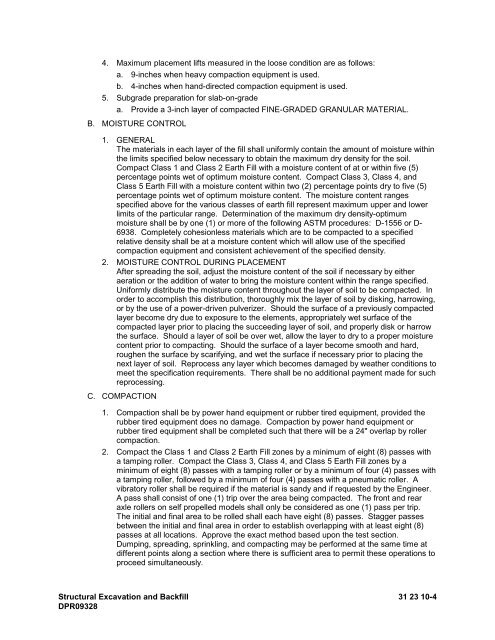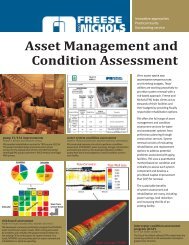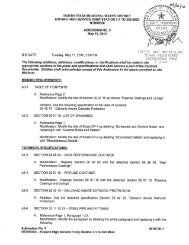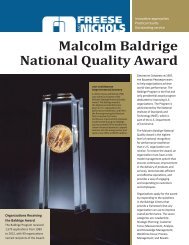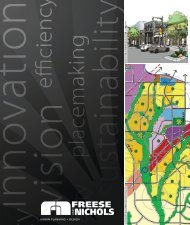final bid specs 09328.pdf - Freese and Nichols, Inc.
final bid specs 09328.pdf - Freese and Nichols, Inc.
final bid specs 09328.pdf - Freese and Nichols, Inc.
You also want an ePaper? Increase the reach of your titles
YUMPU automatically turns print PDFs into web optimized ePapers that Google loves.
4. Maximum placement lifts measured in the loose condition are as follows:<br />
a. 9-inches when heavy compaction equipment is used.<br />
b. 4-inches when h<strong>and</strong>-directed compaction equipment is used.<br />
5. Subgrade preparation for slab-on-grade<br />
a. Provide a 3-inch layer of compacted FINE-GRADED GRANULAR MATERIAL.<br />
B. MOISTURE CONTROL<br />
1. GENERAL<br />
The materials in each layer of the fill shall uniformly contain the amount of moisture within<br />
the limits specified below necessary to obtain the maximum dry density for the soil.<br />
Compact Class 1 <strong>and</strong> Class 2 Earth Fill with a moisture content of at or within five (5)<br />
percentage points wet of optimum moisture content. Compact Class 3, Class 4, <strong>and</strong><br />
Class 5 Earth Fill with a moisture content within two (2) percentage points dry to five (5)<br />
percentage points wet of optimum moisture content. The moisture content ranges<br />
specified above for the various classes of earth fill represent maximum upper <strong>and</strong> lower<br />
limits of the particular range. Determination of the maximum dry density-optimum<br />
moisture shall be by one (1) or more of the following ASTM procedures: D-1556 or D-<br />
6938. Completely cohesionless materials which are to be compacted to a specified<br />
relative density shall be at a moisture content which will allow use of the specified<br />
compaction equipment <strong>and</strong> consistent achievement of the specified density.<br />
2. MOISTURE CONTROL DURING PLACEMENT<br />
After spreading the soil, adjust the moisture content of the soil if necessary by either<br />
aeration or the addition of water to bring the moisture content within the range specified.<br />
Uniformly distribute the moisture content throughout the layer of soil to be compacted. In<br />
order to accomplish this distribution, thoroughly mix the layer of soil by disking, harrowing,<br />
or by the use of a power-driven pulverizer. Should the surface of a previously compacted<br />
layer become dry due to exposure to the elements, appropriately wet surface of the<br />
compacted layer prior to placing the succeeding layer of soil, <strong>and</strong> properly disk or harrow<br />
the surface. Should a layer of soil be over wet, allow the layer to dry to a proper moisture<br />
content prior to compacting. Should the surface of a layer become smooth <strong>and</strong> hard,<br />
roughen the surface by scarifying, <strong>and</strong> wet the surface if necessary prior to placing the<br />
next layer of soil. Reprocess any layer which becomes damaged by weather conditions to<br />
meet the specification requirements. There shall be no additional payment made for such<br />
reprocessing.<br />
C. COMPACTION<br />
1. Compaction shall be by power h<strong>and</strong> equipment or rubber tired equipment, provided the<br />
rubber tired equipment does no damage. Compaction by power h<strong>and</strong> equipment or<br />
rubber tired equipment shall be completed such that there will be a 24" overlap by roller<br />
compaction.<br />
2. Compact the Class 1 <strong>and</strong> Class 2 Earth Fill zones by a minimum of eight (8) passes with<br />
a tamping roller. Compact the Class 3, Class 4, <strong>and</strong> Class 5 Earth Fill zones by a<br />
minimum of eight (8) passes with a tamping roller or by a minimum of four (4) passes with<br />
a tamping roller, followed by a minimum of four (4) passes with a pneumatic roller. A<br />
vibratory roller shall be required if the material is s<strong>and</strong>y <strong>and</strong> if requested by the Engineer.<br />
A pass shall consist of one (1) trip over the area being compacted. The front <strong>and</strong> rear<br />
axle rollers on self propelled models shall only be considered as one (1) pass per trip.<br />
The initial <strong>and</strong> <strong>final</strong> area to be rolled shall each have eight (8) passes. Stagger passes<br />
between the initial <strong>and</strong> <strong>final</strong> area in order to establish overlapping with at least eight (8)<br />
passes at all locations. Approve the exact method based upon the test section.<br />
Dumping, spreading, sprinkling, <strong>and</strong> compacting may be performed at the same time at<br />
different points along a section where there is sufficient area to permit these operations to<br />
proceed simultaneously.<br />
Structural Excavation <strong>and</strong> Backfill 31 23 10-4<br />
DPR09328


